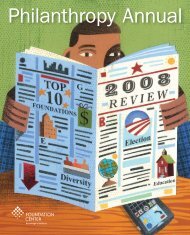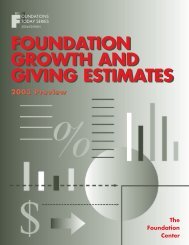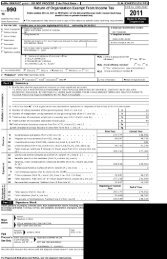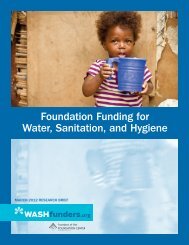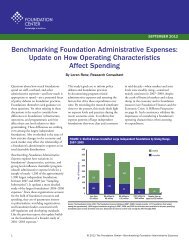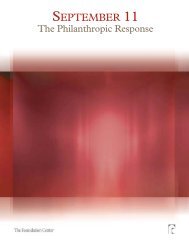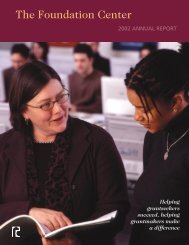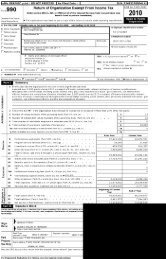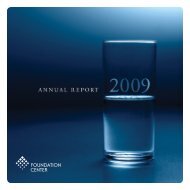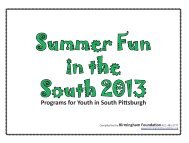Download Philanthropy Annual PDF - Foundation Center
Download Philanthropy Annual PDF - Foundation Center
Download Philanthropy Annual PDF - Foundation Center
Create successful ePaper yourself
Turn your PDF publications into a flip-book with our unique Google optimized e-Paper software.
For More “5 Questions For...” Visit<br />
http://foundationcenter.org/pnd/fivequestions/<br />
GO<br />
That said, President and Mrs.<br />
Obama have been very involved since<br />
their Chicago days in the work we do,<br />
and Michelle Obama continues to volunteer<br />
with us in DC, which is a great<br />
sign of support. And we’re already<br />
seeing encouraging actions from the<br />
administration, including the commitment<br />
by the president and vice president<br />
to end child hunger by 2015 by,<br />
among other things, strengthening the<br />
Child Nutrition and WIC Reauthorization<br />
Act, which focuses on improving free<br />
and reduced school meals programs,<br />
the Summer Food Service Program,<br />
and other efforts to feed children. We<br />
find these commitments and efforts to<br />
be reassuring signs that we’ll continue<br />
to have federal support during this<br />
time of unprecedented need.<br />
PND: What’s the best way for concerned<br />
individuals to help address<br />
the ongoing hunger crisis in America?<br />
VE: First, people can educate themselves<br />
about how pervasive the issue<br />
of hunger is in America. Many people<br />
don’t know that one in eight Americans<br />
is struggling to get enough food for<br />
themselves and/or their families.<br />
Secondly, people can get involved,<br />
either by volunteering or by giving<br />
money directly to us or to a local foodbank.<br />
Those are probably the two best<br />
ways people can help right now.<br />
PND: The New York Times recently<br />
reported that a huge number of newly<br />
unemployed professionals are seeking<br />
volunteer opportunities, creating<br />
a corps of volunteers that, in some<br />
cases, has overwhelmed local nonprofits.<br />
How are foodbanks and other<br />
safety-net organizations utilizing the<br />
influx of volunteers?<br />
VE: Oh, we always have something<br />
for our volunteers to do! We’ve<br />
worked with roughly a<br />
million volunteers at more<br />
than 63,000 agencies<br />
around the country, which<br />
is largely how we deliver food<br />
through our pantries and soup<br />
kitchens, Boys & Girls Clubs, senior<br />
assistance homes, et cetera. And<br />
with demand up an average of 30<br />
percent, as you noted earlier, that<br />
means we have that much more<br />
work to do. So the influx of volunteers<br />
is great for us. We recently<br />
held our annual meeting in Orlando<br />
and had 180 volunteers pack more<br />
than 7,000 boxes for the Orlando<br />
foodbank in preparation for hurricane<br />
season — boxes, should they<br />
be needed, that will help get a lot<br />
of families through a really tough<br />
few days. We love our volunteers.<br />
They’re really instrumental in helping<br />
us do our work<br />
— Lauren Kelley<br />
Julie Rogers<br />
President, Eugene and Agnes E. Meyer <strong>Foundation</strong><br />
For more than 65 years, the Eugene and Agnes E.<br />
Meyer <strong>Foundation</strong> has supported small and midsize<br />
nonprofits serving the most vulnerable residents in<br />
the greater Washington, DC, area, worked to identify visionary local nonprofit<br />
leaders, and made grants that strengthen the region’s philanthropic community.<br />
Like many other foundations, Meyer saw the value of its endowment decline<br />
by roughly 30 percent in 2008. Rather than cut its 2009 grantmaking budget<br />
proportionately, the foundation decided to make adjustments in other areas.<br />
Its grantmaking for 2009 is expected to be $7.3 million, compared to<br />
$8 million in 2008; the foundation will continue to provide its grantees<br />
with general support and grants for financial management, governance, and<br />
organizational assessment, as well as short-term cash-flow loans.<br />
In spring 2009, <strong>Philanthropy</strong> News Digest spoke with Julie Rogers,<br />
president of the foundation since 1986, about what nonprofits can do to<br />
weather the economic storm, the impact of the tough fundraising climate<br />
on executive turnover in the sector, and the prospects for a renewed sense of<br />
public service in the country.<br />
<strong>Philanthropy</strong> News Digest: Will<br />
2009 be remembered as the “Year of<br />
the Survival of the Fittest?” What are<br />
your grantees doing to stay afloat?<br />
Julie Rogers: Savvy nonprofit<br />
leaders are protecting the core of<br />
their organizations’ work by planning<br />
contingencies and helping their<br />
boards act decisively and quickly.<br />
They are communicating their actions<br />
clearly to key constituencies and<br />
staying close to funders, even those<br />
that can’t fund them this year. A<br />
longtime Meyer grantee, Bread for the<br />
City, wrote an open letter about how<br />
it decided to face its own economic<br />
circumstances. It cut services fairly<br />
dramatically, for instance, and it also<br />
cut staff and salaries. The organization<br />
was courageous in the very<br />
public way in which it put the news<br />
out there to its constituents, including<br />
what percent salaries were cut.<br />
People Who Make a Difference | 45



